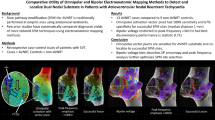Abstract
The study was designed to identify the influence of ibutilide on activation during atrial fibrillation (AF) and determine its role in enhancing the efficacy of electrical conversion of AF. Vagally-mediated acute AF was induced in 12 anesthetized dogs. In 5 dogs, a cross-shaped epicardial patch containing 16 recording electrodes was placed on the right atrium. In 7 dogs, defibrillation patch electrodes overlying both atria were used to deliver biphasic shocks (50% tilt; 90 °F). Measurements were made at baseline and following ibutilide (0.075 mg/kg bolus followed by 0.075 mg/kg infusion over 10 minutes). Right atrial multisite electrogram recordings revealed significant prolongation in AF cycle length at all sites following ibutilide. In all dogs, AF cycle length increased with ibutilide from 90±23 to 130±49 ms (p < 0.005). Whereas, atrial defibrillation threshold decreased from 0.83±0.5 to 0.53±0.29 J (p =0.020). In conclusion, ibutilide prolongs cycle length of canine vagally-mediated acute AF. Furthermore, ibutilide facilitates electrical conversion of AF by lowering energy requirement. Thus, controlled drug infusion in conjunction with electrical defibrillation may be useful for managing AF.
Similar content being viewed by others
References
Kannel WB, Abbott RD, Savage DD, et al. Epidemiologic features of chronic atrial fibrillation: the Framingham study. N Engl J Med 1982; 306:1018–1022.
Kannel WB, Wolf PA. Epidemiology of atrial fibrillation. In: Falk RH, and Podrid PJ, eds. Atrial Fibrillation: Mechanisms and Managment. New York: Raven Press, Ltd., 1992: 81–92.
Lévy S, Richard P. Is there any indication for an intracardiac defibrillator for the treatment of atrial fibrillation? J Cardiovasc Electrophysiol 1994;5:982–985.
Wharton JM, Johnson EE. Catheter based atrial defibrillation. PACE 1994;17:1058–1066.
Mirowski M, Mower MM. An automatic implantable defibrillator for recurrent atrial tachycarrhythmias. In: Tauboul P, Waldo AL, eds. Atrial Arrhythmias: Current concepts and Management. St. Louis: Mosby Yearbook, 1990: 419–421.
Kumagai K, Yamanouchi Y, Tashiro N, et al. Low energy synchronous transcatheter cardioversion of atrial flutter/ fibrillation in the dog. J Am Coll Cardiol 1990;16: 497–450.
Powell A, Garan H, McGovern B, et al. Low energy conversion of atrial fibrillation in the sheep. J Am Coll Cardiol 1992;20:707–711.
Cooper RAS, Alferness CA, Smith WM, et al. Internal Cardioversion of Atrial Fibrillation in Sheep. Circulation 1993;87:1673–1686.
Levy S, Ricard P, Lau CP, et al. Multicenter low energy transvenous atrial defibrillation (XAD) trial [abstract]. Circulation 1995;92:I–472.
Hester JB, Gibson JK, Cimini MG, et al. N-[(w-Amino-1-hydroxyalkyl) phenyl]methanesulfonamide derivatives with class III antiarrhythmic activity. J Med Chem 1991;34: 3008–3015.
Lee KS. Ibutilide, a new compound with potent class III antiarrhythmic activity, activates a slow inward Na+ current in guinea pig ventricular cells. J Pharmacol Exp Therapy 1992;262:99–108.
Yang T, Snyders DJ, Roden D. Ibutilide, a methansulfonanilide antiarrhythmic, is a potent blocker of the rapidly activating delayed rectifier K+ current (IKr) in AT-1 cells. Concentration-, time-, voltage-, and use-dependent effects. Circulation 1995;91:1799–1806.
Buchanan LV, Kabell G, Gibson JK. Acute intravenous conversion of canine atrial flutter: comparison of antiarrhythmic agents. J Cardiovasc Pharmacol 1995;25:539–544.
Nabih MA, Prcevski P, Fromm BS, et al. Effect of ibutilide, a new class III agent, on sustained atrial fibrillation in a canine model of acute ischemia and myocardial dysfunction induced by microembolization. PACE 1993;16:1975–1983.
Buchanan LV, Turcotte UM, Kabell GG, et al. Antiarrhythmic and electrophysiologic effects of ibutilide in a chronic canine model of atrial flutter. J Cardiovasc Pharmacol 1993;22:10–14.
Buchanan LV, Kabell GG, Turcotte UM, et al. Effects of ibutilide on spontaneous and induced ventricular arrhythmias in 24-hour canine myocardial infarction: a comparative study with sotalol and encainide. J Cardiovasc Pharmacol 1992;19:256–263.
Wesley RC, Farkhani F, Morgan D, et al. Ibutilide: enhanced defibrillation via plateau sodium activation. Am J Physiol (Heart Circ Physiol) 1993;264(33):H1269–H1274.
Friedrichs GS, Chi L, Black SC, et al. Antifibrillatory effects of ibutilide in the rabbit isolated heart: mediation via ATP-dependent potassium channels. J Pharm Exp Ther 1993;266:1348–54.
Ellenbogen KA, Stambler BS, Wood MA, et al. Efficacy of intravenous ibutilide for rapid termination of atrial fibrillation and atrial flutter: a dose-response study. J Am Coll Cardiol 1996;28:130–136.
Stambler BS, Wood MA, Ellenbogen KA, et al. Efficacy and safety of repeated intravenous doses of ibutilide for rapid conversion of atrial flutter or fibrillation. Circulation 1996;94:1613–1621.
Nitta J, Khoury DS. Role of proximal electrode position in transvenous ventricular defibrillation. Ann Biomed Eng 1996;24:418–423.
Labhasetwar V, Underwood T, Heil RW, et al. Epicardial administration of ibutilide from polyurethane matrices: effects on defibrillation threshold and electrophysiologic parameters. J Cardiovasc Pharmacol 1994;24:826–840.
Wang J, Feng J, Nattel S. Class III antiarrhythmic drug action in experimental atrial fibrillation. Differences in reverse use dependence and effectiveness between d-sotalol and the new antiarrhythmic drug ambasilide. Circulation 1994;90:2032–2040.
Allessie MA, Lammers WJEP, Bonke FIM, et al. Experimental evaluation of Moe's multiple wavelet hypothesis of atrial fibrillation. In: Zipes DP, Jalife J, eds. Cardiac Electrophysiology and Arrhythmias. Orlando, Florida: Grune and Stratton, 1985;265–275.
Allessie M, Kirchhof C, Scheffer GJ, et al. Regional control of atrial fibrillation by rapid pacing in conscious dogs. Circulation 1991; 84:1689–1697.
Echt DS, Black JN, Barbey JT, et al. Evaluation of antiarrhythmic drugs on defibrillation energy requirements in dogs. Circulation 1989; 79:1106–1117.
Tsai TD, Lee EW, Lee KS. Membrane activity of ibutilide compared to d-sotalol, sematilide, E-4031 and UK-68798 in guinea pig ventricular cells. Upjohn Technical Report 7243-92-017, April 13, 1992.
Baker BM, Botteron GW, Ambos HD, et al. The effects of amiodarone, sotalol, and procainamide on internal atrial defibrillation threshold [abstract]. Circulation 1995;92:I–473.
Wijffels MCEF, Kirchhof CJHJ, Dorland R, et al. Atrial fibrillation begets atrial fibrillation. A study in awake chronically instrumented goats. Circulation 1995;92: 1954–1968.
Rights and permissions
About this article
Cite this article
Khoury, D.S., Assar, M.D. & Sun, H. Pharmacologic Enhancement of Atrial Electrical Defibrillation Efficacy: Role of Ibutilide. J Interv Card Electrophysiol 1, 291–298 (1997). https://doi.org/10.1023/A:1009781026210
Issue Date:
DOI: https://doi.org/10.1023/A:1009781026210




